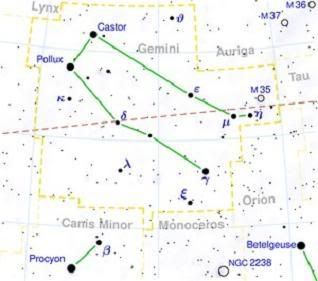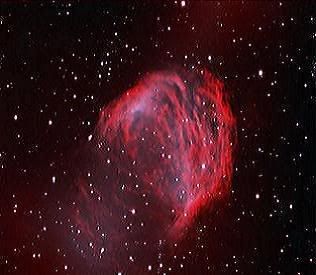Post by glactus on Feb 17, 2008 8:13:15 GMT

Gemini (the Twins), is the most northerly constellation of the zodiac. This Constellation contains the Summer Solstice, passed by the Sun on the first day of northern summer. The eclipic passes just north of Wasat, a double star, pale white and purple, on the right arm of castor.
Gemini has three stars with orbiting planets: Pollux, HR 2877, and HD 50554.
4 of the Main stars:
Polux, one of a twin, and one of the two major stars, is farthest to the left of this constellation
Castor, the other twin to Polux, blue-white in color, was the first star to be recognized as a binary or double pair, one of which is slightly brighter than the other.
Mekbuda (also known as the the "Zeta Gem"), which shines with a yellow-white light.
Alhena (sometimes referred to as "Al Hena"), the third brightest star of the constellation, brilliant white in color and located in the left foot of Castor.
Notable objects:

NGC 2392 the famous eskimo nebula
NGC 2392 lies about 5000 light-years away and is visible with a small telescope. The Eskimo's face is formed from a bubble of material being blown into space by the central star's intense wind of high-speed material. It is surrounded by gas that composed the outer layers of a Sun-like star. Magnitude is 9.1

NGC 2158
This object is well known as an old Galactic open cluster and its age has been estimated at about 1.05 billion years. NGC 2158 is at a distance of 16 light years and has a magnitude of 8.6

Abel 21 - The Meduca nebula
The Medusa is a very old and large planetary nebula on the Gemini / Canis Minor border. It is 1000 light years away from us and is so big, its surface brightness is very low, with a magnitude of between +15.99 and +25 reported. Because of this it is recommend to use at least an 8-inch telescope with an OIII filter. The Medusa was discovered in 1955, and until the early 1980s it was thought to be a supernova remnant.

credits:
Gemini map: wikipedia
en.wikipedia.org/wiki/Gemini_(constellation)
image: eskimo
spider.ipac.caltech.edu/staff/bertinco/
image: NGC 2158
www.cfht.hawaii.edu/News/MegaPrime/MegaPrime-PR-AstroImage-M35NGC2158.html
image: the medusa nebula
www.yankeerobotics.com/images2.html


